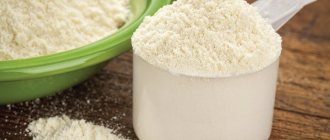Creatine is a sports nutrition supplement that is taken to gain muscle mass and increase strength; the active substance increases muscle strength and accelerates their growth. There are several types of creatine and ways to take it. Proper use of the supplement will speed up your workout results. From the article you will learn how to take creatine correctly and with what for better absorption and results from use.
- What is creatine for? At what age can you use it?
- Is it worth taking it at all?
- When can you start using the supplement?
- In capsules
- Loading
- On rest days
- With gainer
- Creatine with transport systems
What is creatine for?
First, let’s figure out why you should drink creatine in order to better understand what results you should expect and how to influence the effectiveness of the supplement.
Creatine is produced by the body independently; it is a carboxylic nitrogen-containing acid that is involved in energy metabolism and the production of ATP where energy is needed, including muscles.
First of all, the action of the supplement allows you to increase the amount of energy while maintaining the amount of adenosine triphosphate in muscle myofibrils during their contraction.
Secondly, creatine replenishes cells with calcium ions, which are capable of retaining water in the muscles to enhance contraction, therefore, it can be used to increase the strength of an athlete. In workouts that require explosive strength (during anaerobic activity), the supplement will allow the muscles to lift more weight and increase the load. This is what will lead to further muscle growth. The more strength, the greater the performance of the training aimed at gaining mass, but subject to proper nutrition.
It is worth understanding that creatine forces a lot of water into the cells, this causes the volumes to increase sharply; this will not be an increase in pure muscle mass, but only liquid. It also speeds up the recovery process because it neutralizes lactic acid, which increases muscle fatigue and causes pain.
Learn more about what creatine is needed for and its properties.
At what age is it possible?
Since creatine is present in the human body from birth, there are no specific limits for use in children unless the supplement is necessary for medical purposes and is prescribed by a doctor. The benefits of using the supplement increase with strength training, which can be performed by a stronger body that is capable of performing heavy physical activity.
Additional intake of the supplement reduces the production of your own creatine, and weakening of bone tissue is also possible, so it is better to start taking the supplement at least from 16-18 years of age.
Is it worth taking it at all?
The supplement works when dosed correctly for those who need to increase strength during anaerobic exercise. You should not expect that creatine will directly affect the increase in muscle mass, since it is a non-hormonal drug. Muscle growth will only occur in combination with proper exercise, rest and nutrition. Therefore, you need to clearly define the purposes of use and understand that creatine gives strength, and use the supplement for its intended purpose.
Contraindications
Creatine monohydrate powder is the most researched dietary supplement. Researchers in the field of biochemistry claim that it has no harmful effects on the body. But this does not exclude individual reactions to individual components.
It is not recommended to use if you have:
- allergic reactions;
- hormonal imbalances;
- asthma or difficulty breathing;
- thyroid diseases;
- pregnancy or lactation;
- chronic kidney or liver disease;
Chronic stomach diseases may worsen due to insufficient water intake while taking the supplement. Digestive disorders can lead to indigestion, cramps, intestinal colic, or persistent nausea.
In addition, people with acne often experience an increase in the number of breakouts. Such complications can only occur in the event of a sharp increase in dosage or taking expired products.
Creatine use is contraindicated for minors.
Instructions for using creatine - the best ways
Monohydrate is the most studied and preferred form and provides the best results.
The supplement is taken in 2 ways:
- No download. 5 g of the substance in capsules is washed down with a glass of water, or in powder form, diluted with water (juice, gainer) about 250-300 ml. Taken in the morning on an empty stomach on rest days, or during the day before training.
- Loading. Take 20 g of the substance per day for 7 days, dividing the dose into 4 servings (5 g each). Taken between meals, washed down or diluted with juice and water. This method of use is allowed for no more than a week, after which the dose is reduced to 5 g per day for another 3-5 weeks.
You can calculate the dosage of creatine using the formula:
Loading 5-7 days : 0.3 g per kilogram of own weight.
Unloaded : 0.1 g per kilogram of dead weight.
When can you start using the supplement?
From the moment newcomers join the gym, it is a mistake to rely on taking all kinds of supplements at once, with the exception of amino acids and meal replacement supplements. The fact is that the muscles must independently adapt to the load, begin to work, the beginner must learn to feel the muscles and their contraction. Adaptation to stress occurs within a month of regular training. Only then can strength be added to trained muscles with the help of creatine.
For weight gain
The most preferred method of administration for muscle growth is loading with creatine for 7 days, this will allow you to achieve a high concentration of the substance in the blood, significantly accumulating energy and water to increase strength - muscle contractility. Reducing the dose from the second week to 5 g will ensure that the concentration of the substance is maintained.
During drying and weight loss
It is not recommended to use creatine while cutting, because it is an unnecessary additive when burning fat to improve muscle definition, since it contradicts the goals. Its ability to retain water will interfere with the necessary “draining” of fluid from the muscles in order to view the relief. Moreover, creatine is better absorbed with simple carbohydrates, and during a cutting diet they are strictly prohibited.
For running and similar sports
For any aerobic exercise, creatine is ineffective compared to anaerobic exercise because it only works for exercises performed for no longer than 30 seconds. Therefore, when performing endurance exercise for a long time, taking creatine is not justified. In addition, fluid retention in the muscles will make it difficult for the muscles to work and lead to rapid fatigue.
How and what to mix with, how much water to drink
Any liquid is suitable for mixing creatine - water, juices, protein shakes, gainers and pre-workout complexes. 300 ml of liquid is enough; the powder is easily mixed with a spoon or in a shaker.
Which juice to take with for better absorption?
For best absorption of the substance, insulin is needed. Insulin is produced by the body when it receives simple carbohydrates with a high glycemic index, in other words, sugar. Sugar is found in high concentrations in grape juice, which increases insulin release better than any other drink.
Creatine is also well absorbed together with a high-carbohydrate gainer; the more sugar it contains, the better.
What time to drink?
It is better to take a single dose of the substance on rest days in the morning, during high concentrations of growth hormone. On training days, despite new research results that are full of information on the Internet, it is best to take the supplement 30-40 minutes before training. This will increase the concentration of the substance during physical activity, which is more effective when consuming creatine before training.
Is it possible on an empty stomach?
It is better to take creatine after meals, rather than on an empty stomach, this will not only protect the walls of the stomach, but also carbohydrates from food will facilitate the transport and absorption of the substance in the blood.
Links[edit | edit code]
- Mayhew, D. L., Mayhew, J. L., & Ware, J. S. (2002). Effects of long-term creatine supplementation on liver and kidney functions in American college football players. International Journal of Sport Nutrition and Exercise Metabolism, 12, 453-460
- Schedel, J. M., H. Tanaka, A. Kiyonaga, M. Shindo, Y. Schutz
- Burke, D. G.; Candow, D. G.; Chilibeck, P. D.; MacNeil, L. G.; Roy, B. D.; Tarnopolsky, MA; Ziegenfuss, T (2008). "Effect of creatine supplementation and resistance-exercise training on muscle insulin-like growth factor in young adults." International journal of sport nutrition and exercise metabolism 18 (4): 389–98.
- Chen, J.; Wang, M.; Kong, Y.; Ma, H.; Zou, S. (2011). "Comparison of the novel compounds creatine and pyruvateon lipid and protein metabolism in broiler chickens." Animal 5(7):1082–9.
- Clin J Sport Med. 2009. Three weeks of creatine monohydrate supplementation affects dihydrotestosterone to testosterone ratio in college-aged rugby players. van der Merwe J1, Brooks NE, Myburgh KH.
How to take different release forms
In capsules
A form of creatine with a highly stomach-soluble coating. This form is most convenient, washed down with water or juice. The dose of one capsule differs markedly from different manufacturers. It is necessary to take capsules based on the daily dose, when loading - up to 20 g, daily intake from the second week of the course - 5 g.
Powder
The powder of the pure substance is available in jars with a measuring spoon, diluted with water or juice in a volume of 250-300 ml. This is the most economical form because the powder lasts longer. It is also taken, with or without a loading system, 20 g in the first week, then 5 g each.
In tablets
The compressed form of uncoated tablets may also contain vitamins and other substances. Take it with water, at least 300 ml. As with any form of creatine, you should not exceed your daily dose, loading or not.
Before/after meals
It is unlikely that the instructions for use of creatine preparations in the “Method of administration and dosage” section will indicate the specifics of taking creatine in relation to food. There is a lot of controversy on this topic. According to a common misconception, the acidic environment of the stomach can destroy creatinine, and therefore it is better to take the drug before meals - the absorption rate will increase.
Creatine is a real helper in the growth of “lean” muscles
Modern research has confirmed that creatine is not destroyed in acidic environments, and therefore the use of the product is always allowed. Experts generally recommend taking the drug strictly between meals. However, if the rule is sometimes broken, there will be no negative effect.
Reception regimens
Loading
High dosages of creatine in a short period of time allow the maximum accumulation of the substance in the body, which will contribute to high results during strength training. This method also quickly floods the muscles with water, as opposed to taking small dosages, this will allow the muscles to receive more energy and strength. In the first 7 days, the maximum dosage of creatine is taken - 20 g per day. Divide this dose into 4 times 5 g each (regardless of the release form). Take after meals containing proteins and carbohydrates. Before training, 5 g is taken 30-40 minutes before training. After a week of loading, take a one-time dose of 5 g of creatine per day for 1-2 months.
No download
This method provides a constant daily dose of 5 g. Creatine is taken daily both on rest days (in the morning) and before training 30-40 minutes. This scheme is accepted within 1-1.5 months, but no more than two. After which you need to take a break for 2-4 weeks.
Cycling
This scheme involves using the supplement for 3 days, after which a rest period is also taken for 3 days. The author of the technique believes that constant intake of creatine impairs its penetration into cell membranes. Although studies have proven the inappropriateness of this system, since the high concentration of creatine in the blood does not fall and does not suppress the synthesis of transporters with daily supplementation for a month.
Low dosages
Low dosages will not significantly impact training performance, strength gains, or recovery. Taking small doses of pure creatine will be in vain, but when sports nutrition manufacturers add 1-2 g of creatine to pre-workout complexes, it will improve the effectiveness of the energy properties of the supplement.
Which way is better?
In bodybuilding, during the period of mass gain, it is preferable to start using it from the loading phase, thereby accelerating the effect of the supplement by accumulating creatine in the body. From the second week, maintaining doses of 5 g will ensure a stable supply of the substance necessary for a quality workout.
When is the best time to take creatine?
There is often information about the effectiveness of taking creatine after training, arguing that after exercise the body is able to absorb all the incoming substances much better than at other times. But post-workout time is most favorable for the absorption of nutrients that fill muscles with building material and replenish energy reserves spent when muscles are damaged during training. And creatine, which is taken just before training 30-40 minutes for absorption, can ensure maximum strength and muscle function for further growth (in case of muscle damage and restoration).
On rest days
On non-training days, maintaining creatine concentrations is also necessary. A single dose is taken in the morning with carbohydrates. If the rest day falls during the loading phase, then the regimen does not change - 4 doses of 5 g each.
For the night
Drinking before bed makes sense during the loading phase, when the last time is in the evening. Without loading, a daily dose (5 g) at night will not bring benefit, unlike taking it in the morning. Although creatine in the blood will be at the proper level, at night the body does not need to produce the energy that is needed during physical activity.
For people who do not play sports
There is no point in taking creatine without exercise. If a person does not need additional strength in muscles that are not under stress, the effect of creatine is completely unjustified. It will only contribute to the accumulation of water in the body, and has nothing to do with increasing muscle mass. Therefore, this supplement is necessary only for athletes during anaerobic exercise.
Benefit
- reduces the level of “bad” cholesterol;
- promotes rapid recovery of muscle tissue after intense growth and intense physical activity;
- helps with atrophic changes and weakness of the muscle corset;
- has an anti-inflammatory effect;
- helps build muscle mass;
- improves brain activity;
- restores hair.
Despite the many beneficial properties, you should not abuse the supplement.
How to take with other supplements
With gainer
Since creatine is best absorbed with carbohydrates, taking it with a gainer is quite justified, since it contains a high content of simple carbohydrates. It is better to take this cocktail before training to fill the body with energy and substances (including creatine) that accelerate further weight gain.
With protein
Good absorption of creatine as part of a protein shake has also been proven; this mixture is taken before training or in the morning on rest days. Powder forms are mixed together or taken at separate times.
Full cycle amino acids and BCAA
The amino acid content of creatine also accelerates the process of its absorption and, together, ensures the growth of muscle mass with the release of branched chain amino acids.
With glutamine
Glutamine is an important component involved in insulin metabolism, which improves the absorption of creatine. Supplements can be taken both simultaneously or separately (depending on the form of release), without exceeding the daily dosage.
Is it possible with coffee and caffeine?
Caffeine is not recommended to be taken with the supplement, since caffeine has the ability to remove excess fluid, it will interfere with the fluid retention of creatine, which increases strength.
With L-carnitine
These supplements will serve as an additional source of energy during exercise. L-carnitine plays the role of transporting fatty acids to muscles for the production of ATP (energy), the production of which also involves creatine.
Reception of other types
Creatine with transport systems
This is a form with the addition of substances that accelerate the absorption of the supplement, for example, carbohydrates, amino acids, vitamins. The disadvantage of this “move” by manufacturers is that the cost of the additive increases significantly, but the effectiveness is no better than when mixed with grape juice or gainer. Creatine is also taken according to two standard regimens, without exceeding the dosage.
Crealkalin
This product is a mixture of creatine and alkaline, which neutralizes stomach acid, improving the absorption of creatine. Also prevents the accumulation of lactic acid. It is not recommended to exceed the dosage of 5 g per day, when loading - 20 g.
Creatine malate
The malic acid form has a sour taste and is highly soluble in water. Malic acid may increase endurance. It is taken according to standard dosage and dosage regimens, both on training days and on rest days.
Nitrate
Nitrate is an ester of creatine combined with a nitric oxide molecule. The supplement is used to increase strength and muscle growth according to the standard regimen, like monohydrate. The daily dose does not exceed 5 g, when loading - 20 g.
Phosphate
Creatine phosphate is considered a purer product, and one of the main advantages is its ease of administration. The downside is the higher cost. The sports supplement is taken in the morning every day (on rest and training days).
Hydrochloride
Creatine hydrochloride is produced by adding creatine to a hydrochloride group, which produces a salt. Hydrochloride significantly increases the solubility of the creatine molecule; 1 g per day is enough for this type of supplement, unlike monohydrate. Taken in the morning or before training.
Citrate
Consists of creatine molecules to which citric acid molecules are attached. The citrate form contains 1 g less creatine than the monohydrate, but citrate is more easily soluble in water.
Precautions for use
Using creatine as a sports supplement has a number of points to consider:
- be sure to take the drug cyclically, i.e. you should take breaks in courses;
- You should not exceed the dosage of the drug and prescribe maximum doses for yourself for the “best” effect, since the body at very high doses will stop producing creatine on its own;
- increasing the dosage leads to addiction, which hinders progress in training and strength indicators;
- do not take the drug on an empty stomach - this way you can cause indigestion and mistakenly take it for intolerance to the creatine supplement;
- pregnancy is not a strict contraindication for use, but you should definitely consult a doctor, as well as for the lactation period;
- Taking the drug at the age of 50+ may cause a slight increase in blood pressure, so women in this age group should closely monitor their health.











